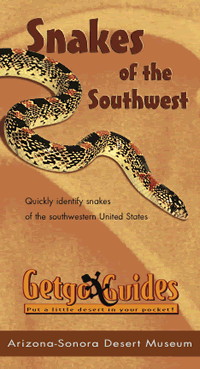Snakes of the Southwest

Order here
At this time, online book sales through the Desert Museum's web site have been temporarily disabled. We encourage you to visit us in person and browse our extensive book collection at our Gift Shops.
Craig Ivanyi and Janis Johnson
$4.95
$4.46 Member Price
2006
ISBN: 1-886679-31-2
Laminated, full color throughout
Folds to 3.25 x 6 inches
Description
A forked tongue... no voice... eyes that never close... dry scaly skin and long limbless bodies that appear to ooze across the ground - often under the cover of the night. Sounds like a mutant beast from a horror movie, right? Not quite - instead, it describes one of the most fascinating and highly evolved groups of animals ever to inhabit planet earth - snakes!
Before you run for cover, take a few minutes to get to know a little more about these phenomenal predators. You might lose some of your fear of them and gain respect (perhaps even a bit of awe) once you know what they do and how they do it!
Snakes are believed to have evolved from lizards during the Cretaceous (about 150 million years ago). It seems counter-intuitive that there would be any advantage to losing moveable eyelids, legs, arms, and the bony armatures that support them. But their long, flexible, and powerful bodies allow them to go places and do things that lizards can't. Though they have more bones than lizards (some snakes have more than 400 vertebrae!), the bones are reduced to thinner, more delicate and flexible forms. Combine this with a tube-shaped body, flexible skull, extra bones in the lower jaw, a moveable windpipe (glottis), and really stretchy skin and you have a predator that can capture, kill, and swallow animals 3 to 5 times the diameter of its head.
In addition, during the transition from lizard to snake, some other things were lost, such as external ear openings and some of the ear bones. Though snakes don't appear to detect airborne vibrations very well, they do have some hearing, so they are not totally deaf. Still other features were refined and perfected, like how they pick up and analyze scent. Some lizards have forked tongues, but most do not. All snakes have forked tongues that allow them to accurately pick up and follow scent trails left by other animals. This ability lets them effectively follow prey trails by picking up and transferring chemical information, deposited on the ground or wafting through air, from the tongue into the vomeronasal (Jacobson's) organ, where it can be analyzed.
Remember - snakes are not aggressive, but they can be highly defensive when confronted or provoked by us. So be careful where you step and pay attention to where you are going. Give potentially dangerous ones plenty of room, and even these encounters can be safe and enjoyable.
Now that you are armed with knowledge, get out there and allow fear to become fascination, and turn loathing into respect, perhaps even love!










